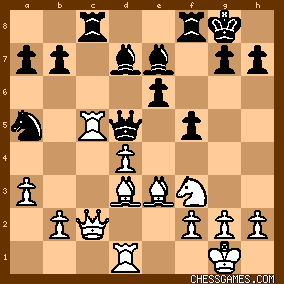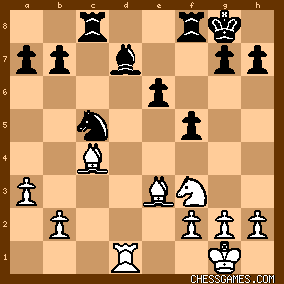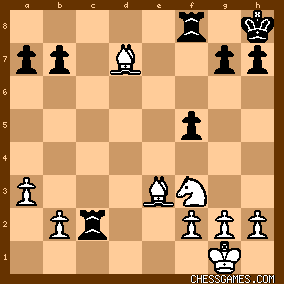| Apr-15-05 | | BlazingArrow56: The endgame looks dead drawn until Tal blazes down the board with his king. Very instructive idea in endings with bishops of opposite color. |
|
| Apr-18-05 | | chesscookie: Quite similar to the Topalov-Shirov game. |
|
Oct-26-05
 | | wwall: If 20...Bxe5, then 21.dxe5 Qxe5 22.Bxa7 Qxe2 23.Bxe2 Rc2 24.Rxd7 Rxe2 25.g3 Rxb2 26.Bd4 Rb1+ 27.Kg2 g5 28.Rg7+ Kf8 29.Rxh7 Nc6 30.Bc5+ Kg8 31.Rh6 Kf7 and this might draw. Perhaps 23.Bc2 or 23.Bb1 Bd1 (23...Qxe5 24.f4 Qd5 25.Bxa7) 24.Qf1. After 23...Bc6, Black threatens mate with 24...Qxg2.
If 39.Bf8, then 39...Bxf3 40.gxf3 Kxf3 41.Bc5 h4 42.Kh2 Ke2 43.Kh3 f4 44.Kxh4 f3 45.Kg5 b5 46.Kf6 b4 wins for Black. If 41.Bf8, then 41...h4 42.Kh2 Ke2 43.Be7 (43.Bh6 b5 44.Kg2 b4 45.Bc1 b3 46.Kh3 f4 wins for Black) f4 44.Bxh4 b5 wins for Black. If 43.Kg1, then 43...Ke2 44.Bc1 b4 45.Kh2 b3 46.Kh3 f4 wins for Black. After 44...Ke2, Black threatens 45...f4, 46...f3, etc. |
|
| Mar-14-06 | | mormonchess: Keres must have been surprised at the Bishop sacrifice. However, it's the best move to make: Black nets two pawns for a Bishop, and as we all know, Pawns are gold in the endgame. Post sacrifice, Black now has four pawns to White's e-pawn and a rather ineffectual Bishop. A nice endgame lesson from the Magician... |
|
| Dec-06-07 | | Cibator: Note how White's last remaining P restricts the range of his bishop. |
|
May-07-08
 | | Honza Cervenka: <mormonchess: Keres must have been surprised at the Bishop sacrifice> I guess that he was not surprized at all but he simply could not prevent it in any satisfactory way. If he would have played let's say 37.Kf2 instead of 37.Bf8, then black would have created mobile Pawn majority on the Kingside without sac of Bishop and with that plus with passed b-Pawn black should have won the ending hands-down despite of opposite colour Bishops. The idea to sac a piece for creation of passers on both wings against opponent's minor piece is quite common idea and here it was rather easy work for black. But the game is really very instructive and pretty example of this pattern. |
|
| May-23-08 | | Vollmer: BOOC endings aren't so drawish if one side has some of his pawns on the wrong color . Tal exploits this with the active king (his only other attacking piece) . A lesson in logic , not magic . I think that while Tal is remembered for initiating enormous complications he also often played with a cold logic that reminds me of Kasparov . Many of their games end with "my last piece (minor or otherwise) is far better than yours" . |
|
| Dec-19-08 | | Gryz: I suppose the ending will be something like:
45. Kh2 f4 46. Kxh3 f3 47. Bc5 b4 48. Bxb4 f2 and there is nothing White can do to prevent 49. ... f1Q. |
|
| Dec-19-08 | | whiteshark: A very interesting exchange sacrifice would have been <18.Rc5!?> 
click for larger view A likely continuation is <18...Bxc5 19.dxc5 Qb3 20.Qxb3 Nxb3 21.Bc4 Nxc5>

click for larger viewwith <22.Rxd7 Nxd7 23.Bxe6+ Kh8 24.Bxd7 Rc2> 
click for larger view with ♗♗♘ vs ♖♖♙ material. About equal. |
|
Dec-19-08
 | | gawain: 39...Bxf3 may not have surprised Keres but Tal does allow himself a (!) for it in his book The Life and Games of Mikhail Tal. This is game 13 in that book. |
|
| Sep-22-10 | | dondiegodelavega: Amazing!
@chesscookie: indeed |
|
| Nov-25-13 | | Chessman1504: This reminds me of Shirov's 47...Bh3!! |
|
| Aug-21-15 | | jerseybob: Keres plays the opening in an odd, ineffective way(5.a3?!) and soon gets saddled with an isolated d-pawn, the protection of which saps the life out of white's game. Keres, being Keres, makes it interesting, but Tal's play is too strong. |
|
| Aug-21-15 | | NeverAgain: The exchange sacrifice <18.Rc5>, proposed by whiteshark, indeed leads by force to a level ending, the odd material balance notwithstanding. In his final diagram Stockfish 6 finds nothing better for Black than picking up the queenside pawns and allowing White to set up a perpetual with Be6 and Ne5->Nf7+:
<25.g3 Rxb2 26.Kg2 b6 27.Ne5 Re2 28.Be6 Re8 29.Nf7+ Kg8 30.Ng5+ Kh8 31.Nf7+> [= 0.00 depth: 40/39 889mN] But even without this sacrifice White was not in any danger of losing throughout this game, until he lashed out impulsively with <23.b4?>. After <23.Bc2 Bxc2 24.Qxc2> Black has no more than an edge [-0.32 37/49 524mN], and not even that if he grabs the e5 pawn
<24...Qxe5 25.Bd2 Qd5 26.Bxa5 Qxa5 27.Rxe6>=
or avoids the exchange of the bishops with
<23...Bc6 24.f4>=
The next (and last) big mistake was exchanging off the last pair of Rooks. White had to try <34.Bf2>. After that White's position was beyond salvation, like Honza sez. BTW, it would be more accurate to classify this game as "Caro-Kann, Panov-Botvinnik Attack (B14)" (which is what Chessbase does). |
|
| Aug-21-15 | | NeverAgain: E.g. <1.e4 c6 2.d4 d5 3.exd5 cxd5 4.c4 Nf6 5.Nc3 e6 6.Nf3 Be7 7.Bf4 Nc6 8.a3 O-O 9.Rc1 Ne4 10.Bd3 Nxc3 11.Rxc3> and we have the same position as in this game. |
|
Aug-21-15
 | | perfidious: <NeverAgain> There are innumerable such cases of incorrect opening nomenclature strewn through the DB. |
|
| Aug-21-15 | | NeverAgain: I recall seeing cg.com explain somewhere that they have to ignore transpositions and go merely by opening moves because of the Opening Explorer or the search engine, or something like that. I just submitted a correction, as "Caro-Kann, Panov-Botvinnik Attack" seems to me a lot more helpful than "Indian Game: Anti-Nimzo-Indian". Curiously, 40 years later a game Mishuchkov vs. Sakaev arrived at the same position on move 16, whereupon White (a 50-year-old IM) diverged with <16.Rc1> and drew his much younger GM opponent (rated 200 points higher to boot) in 53 moves.
http://www.365chess.com/game.php?gi...
The game is classified as "A46 Queen's pawn, Yusupov-Rubinstein system" there, heh. Cases like this make me wonder what the Chess Informant team was smoking when they were designing the ECO system in the 70s. |
|
| Apr-07-16 | | zydeco: There are two different conceptions of chess at work here. Keres plays for harmony and control, while Tal pursues imbalances for their own sake: e.g. 9....Ne4 and the maneuver with 12....Qa5+!? and 14....f5!? |
|
| Mar-13-20 | | Atking: I'm not sure that Rf1 should go on d1 on move 16. 16.b4 a6 17.Re1 for example 17...Bf6 18.Rc5 Qd6 19.d5 exd5 20.Rxd5 Qc7 21.Rxd7 Qxd7 22.Bxf5 Qc7 23.Bxh7+ Kh8 24.Qg6 Qf7 25.Qf5 threatening Qh3. |
|





